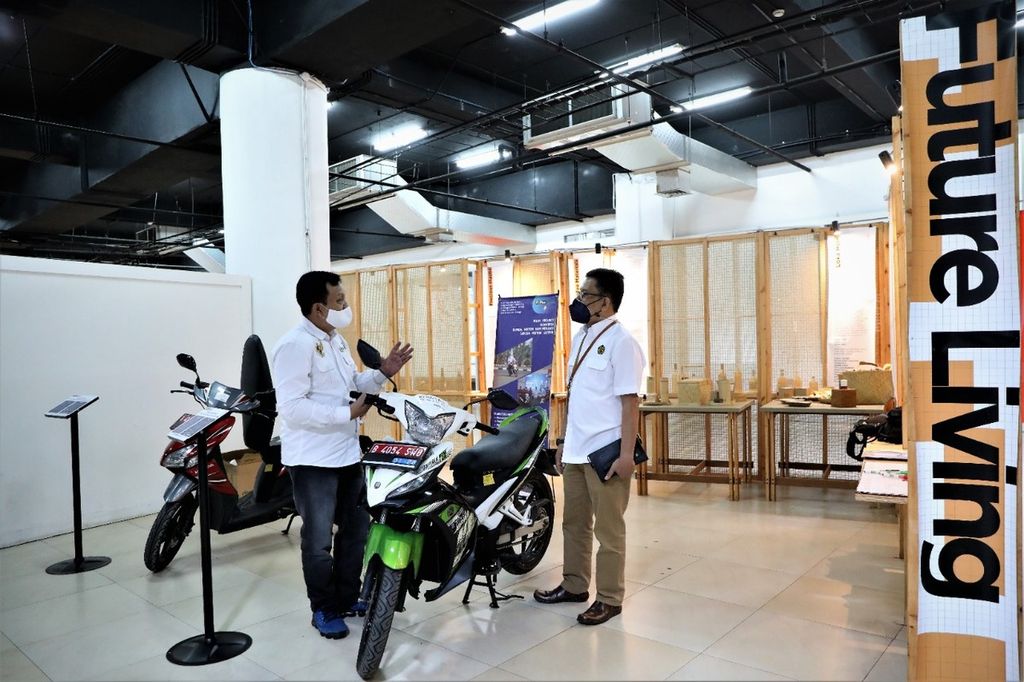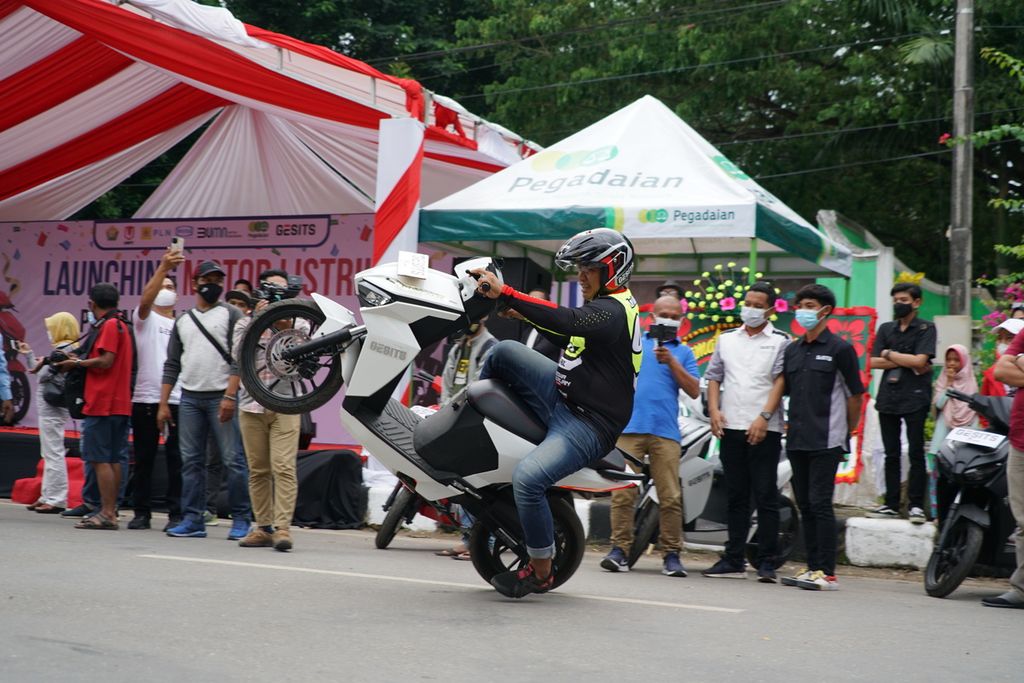Saving More on e-Motorcycles
The average price of an electric motorcycle is Rp 28 million, which is about Rp 3 million more than a conventional motorcycle. It is categorized as a middle-segmented unit.

Conventional motorcycles that have been converted into electric motorcycles are exhibited at the Smesco Building, Jakarta, on Tuesday (8/2/2022).
Electric motorcycle (e-motorcycle) users will save more on monthly expenses compared to fuel-powered (conventional) motorcycle users. While being affordable, electric motorcycles cost less to operate and maintain.
JAKARTA, KOMPAS — A Kompas research showed that the average operating cost of an e-motorcycle is Rp 46,952 (US$3.08) per month. This figure is four times more financially efficient than the operational cost of a fuel-powered motorcycle, which is Rp 201,826. E-motorcycles are more efficient because the operation only requires electricity power through battery charging and the maintenance is 30 percent cheaper than the conventional motorcycle.
Having an e-motorcycle for five years lowers the sum of expenses compared to that of a combustion engine motorcycle. The sum, which is spent on the unit purchasing, maintenance and electricity for the operation, amounts to Rp 32.7 million for an e-motorcycle, compared to Rp 39 million for a combustion engine bike. A five-year use in the comparison is based on the calculations of the estimated battery durability.
Also read:
> More Wasteful with Electric Cars
> Behind the Advantages of Motorcycles without Noise
These economic benefits can be seen further on the composition of household expenditures. Data at Statistics Indonesia (BPS) on the national socio-economic survey in March 2021 showed the average operating costs of a conventional motorcycle accounted for 12.4 percent of Rp 3.5 million of the owner’s household monthly non-food expenditures. A switch to an e-motorcycle will ease the household burden to 2.9 percent on non-food expenditures.
A similar equation was applied in the case of four-wheeled vehicles. The average monthly operating cost of a conventional car is Rp 519,118 or 11.7 percent of household non-food expenditures, which is Rp 6.9 million per month. In contrast, for an e-car owner the figure is Rp 171,049 or 3.9 percent on non-food expenditures.
Given the substantial economic benefits, e-vehicles see promising prospects of growth in Indonesia with more people expected to switch from conventional vehicles. In 2021, the number of motorcycle-owning households was 51.6 million. The figure was 8.2 million households, who owned motorcycles and cars, and 0.57 million for car ownership.
The price comparison is drawn from 15 types of motorcycles produced in 2022.
However, to feel the economic advantages of e-vehicles over conventional vehicles will prompt someone to be willing to make sacrifices early by digging deeper into their pockets, given that the average price of e-motorcycles is about 11 percent higher than conventional motorcycles. The price comparison is drawn from 15 types of motorcycles produced in 2022.
The average price of an electric motorcycle is Rp 28 million, which is about Rp 3 million more than a conventional motorcycle. It is categorized as a middle-segmented unit. Conventional motorcycles with an engine capacity under 125 cc are the most popular two-wheeled vehicles in Indonesia. The selling price of Rp 17.8 million is around Rp 10 million less than middle-segmented units.
This fact contributes to slowing the adoption of electric mobility in Indonesia. The government announced early this year that it targeted the operation of 13 million electric motorcycles by 2030, which means a growth of 1.63 million units on average per year. However, until mid-2022, the number of electric motorcycles has only reached around 18,000 units or only a 0.14 percent fulfillment of the target.
/https%3A%2F%2Fasset.kgnewsroom.com%2Fphoto%2Fpre%2F2018%2F02%2F15%2F72f6a0ce-cc61-4df0-9430-52d77d337351_jpg.jpg)
Transportation Minister Budi Karya Sumadi.
Transportation Minister Budi Karya Sumadi hopes the selling price of e-motorcycles, including their high-power batteries, will be more affordable in order to further help tap the large market potential for the e-motorcycle industry in Indonesia.
Budi believes the mobility transition will bring more economic resilience for the households due to lower daily operating costs for e-vehicles.
Seeing the selling price of e-motorcycles as an obstacle, he appealed to e-motorcycle makers and other industry stakeholders to work together over the possible scaling down of the price tag.
Economic value
For the residents of Agats, Asmat regency, Papua, energy-saving e-motorcycles have become part of their daily life, long before the Presidential Regulation No. 55/2019 was passed. They have begun to get used to riding electric motorcycles since 2009.
Constraining geographical conditions and a limited road infrastructure, as well as the relatively high price of gasoline in the region have contributed to e-motorcycles being prefered to conventional motorcycles.
The maintenance sum does not include Rp 150,000 of an annual retribution fee paid to the local administration based on the regulations.
Simon (37), a native of Agats, said the maintenance cost of his motorcycle was only Rp 500,000 a year. "It is used mostly to replace the tires," he said. The maintenance sum does not include Rp 150,000 of an annual retribution fee paid to the local administration based on the regulations.
In Jakarta, the economic benefits were also acknowledged by Ismail (42), a Go-Ride Electric driver. He said he has been using the Gogoro brand e-motorcycle for the past 10 months, saving up to Rp 800,000 every month.
/https%3A%2F%2Fasset.kgnewsroom.com%2Fphoto%2Fpre%2F2021%2F10%2F12%2F1eb25258-c0e0-4cad-a077-b480e734da9c_jpg.jpg)
A student with his electric bicycle walks along the stage road that divides Agats City, Asmat, Papua, on his way to school, onTuesday (12/10/2021).
When using a conventional motorcycle, he said, the monthly expenses for buying Pertamax (unsubsidized gasoline), periodical replacement of lubricants and routine services were Rp 1.58 million. Now he spends only Rp. 880,000 on rental fees. However, his expenditure would be higher if the cost of routine service and the battery swap was not borne by the Gojek management.
Mass conversion
The Energy and Mineral Resources Ministry has embarked on a program of converting fuel to electric engines as part of the government’s efforts to achieve the target of 13 million e-motorcycles by 2030. Sripeni Inten Cahyani, an expert at the ministry, said the program aims to produce six million e-motorcycles through conversion by 2025.
With the conversion cost estimated at Rp 13 million per unit, the produced e-motorcycles, she said, will be equivalent in specifications to a new Rp 28 million-tagged Gesits e-motorcycle.
“This conversion has been sought to help accelerate the reduction in fuel subsidies. People may buy new electric motorcycles while they still prefer to use the fuel motorcycle,” she said.
Sripeni concedes that the target of the conversion of 1,000 units for this year has yet to be achieved.
The conversion program began in 2021 with the pilot project converting 100 motorcycles from transportation facilities operated within the Energy and Mineral Resources Ministry. Sripeni concedes that the target of the conversion of 1,000 units for this year has yet to be achieved.
She said the program was constrained by difficulties in mobilizing motorcycle owners still showing disinclination due to the relatively costly conversion cost of Rp 13 million. She said people’s affordability for the conversion was between Rp 5 million and Rp 7 million.
Half-hearted policy
Imam Supriyadi, a lecturer in energy sustainability at the Indonesian Defense University, referred to the mass conversion program as a “complex policy,” which was prone to stalling.

Attractions using the Gesits electric motorbike in Kendari, Southeast Sulawesi, on Saturday (27/2/2021).
"Don't let the people end up being burdened if their motorcycles are damaged [because of mal-conversion]," he said.
He added that the government should give equal attention to e-motorcycles users because their daily activities already contributed to energy saving.
Imam urged the government to provide incentives for e-motorcycles in the form of an annual tax easing scheme and down-payment exemptions for credit installments, given the fact that the main obstacle for the lower and middle class community in procuring e-motorcycles was the costly price.
“Electric motorcycles help the lower and middle class a lot. Why not prioritize to heed the interests of these people who will benefit greatly from this transition program? The government should not be half-hearted in this matter,” he said. (SPW/XNA/PUT)
(This article was translated by Musthofid)